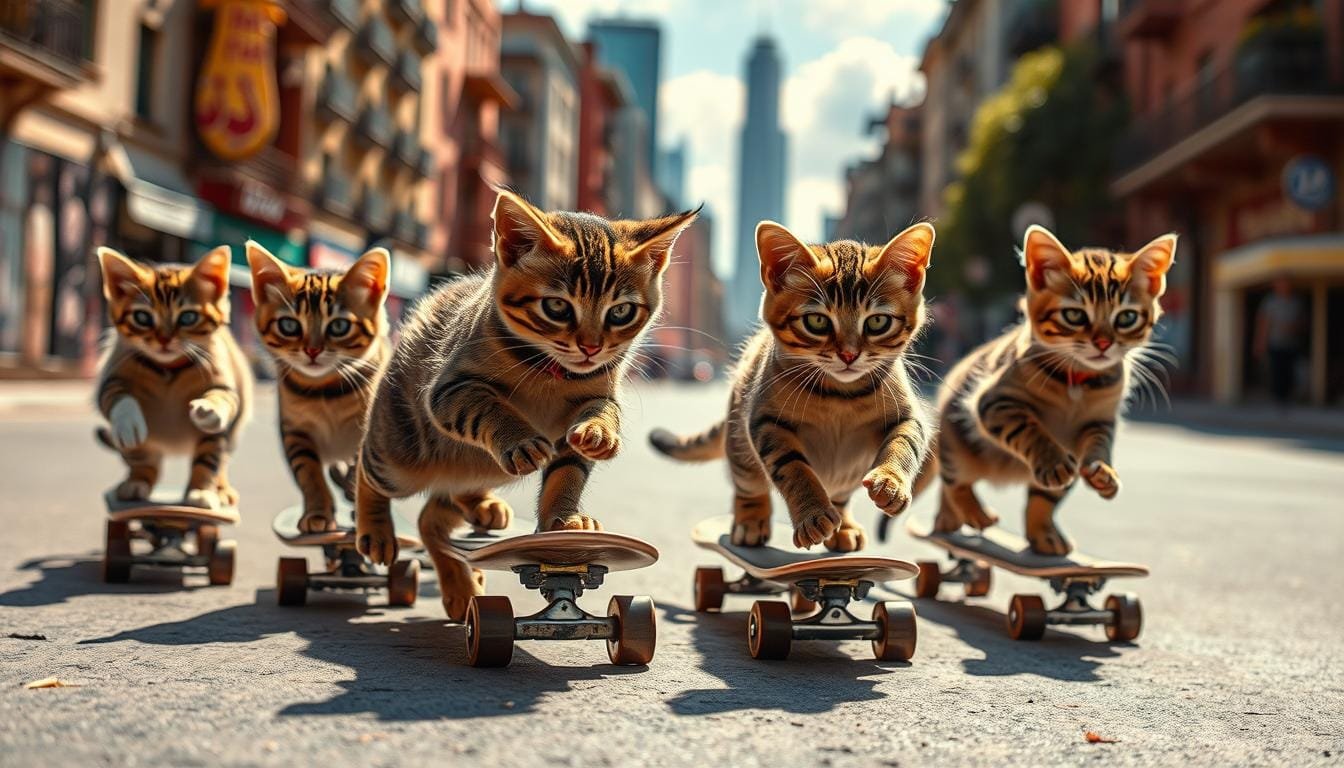Have you ever imagined a cat effortlessly riding a skateboard? That might not be as crazy as you think! Cats on skateboards like Didga and Bao Zi have grabbed the attention of both pet lovers and skaters. These cats show us that they’re not just about naps and chasing mice. They have some serious skills on a skateboard. Let’s explore the possibility of cats skateboarding and share some amazing facts about them!
Key Takeaways
- Bao Zi set a record for the fastest 10 meters on a skateboard by a cat in 12.85 seconds.
- Cats’ natural athleticism, agility, balance, and fast reflexes make them suitable for learning tricks like skateboarding.
- Miniature and modified skateboards can facilitate a cat’s interest in skateboarding.
- Owners like Li, who has over a decade of experience in training animals, have successfully taught cats to skateboard.
- Curiosity often drives cats to interact with skateboards, suggesting a natural inclination toward the activity.
Understanding Your Cat’s Abilities
Cats are as smart as two-year-old humans. They can solve problems, feel emotions, and learn complex behaviors, making training possible. Their brains work like ours, showing their ability to think and remember.
Didga, a rescue cat, learned to skateboard thanks to Robert Dollwet’s training in 2012. Over eight months, Didga moved from simple tasks to impressive tricks like surfing. This shows that patience and consistency can reveal a cat’s true athletic skills.
Cats can do more than skateboard. They see well in the dark and can hear high-pitched sounds thanks to their flexible ears. These abilities prove that cats can learn various tasks with the right training.
Cats slow blink to show trust, which owners can do back to strengthen their bond. These behaviors and emotional understanding prove their intelligence. For more on how smart cats are, check out this article on cat intelligence.
Skateboarding cats are just one example of their curiosity and skill. This trend shows cats are not lazy but capable of amazing things. Understanding and patience can help you discover your cat’s talents.
The Process of Teaching Your Cat to Skateboard
Teaching your cat to skateboard may seem tough, but it’s doable with the right cat training techniques. You’ll start with a strong base, using things like clicker training for cats. This method helps your cat link their actions to getting rewards. Here’s how to start this fun journey of how to teach skateboarding to cats.
Begin by introducing the skateboard in a safe place for your cat. Let them get used to it by sniffing and walking around it. Slowly, use treats to get your cat on the board. Give them a treat or a click for showing interest or stepping on it. Being consistent and patient is very important.
After your cat feels okay getting on and off the board, add some gentle movement. Putting the skateboard on a carpet can help make it quieter and slower. Slowly do more as your cat gets braver. Keep each training short and fun to keep your cat interested.
Along with clicker training, other cat training techniques can also help. Positive reinforcement can be anything from praise to treats. Celebrate each achievement with your cat. This strengthens their learning and your bond.
| Resource | Details |
|---|---|
| Didga’s Guinness World Record | 24 tricks in one minute |
| Most-Watched Training Video | 23 million views |
| Popular Training Pages | CATMANTOO’s Facebook and YouTube |
| Duration for Advanced Tricks | 1.5 years |
Learning from skilled trainers, like CATMANTOO who is well-known and respected, really helps. The secret to how to teach skateboarding to cats is being patient, sticking with it, and using lots of positive reinforcement.
Real-Life Examples of Cats on Skateboards
Didga and Bao Zi are famous skateboarding cats who set amazing examples. Didga, known as the Didga cat skateboarder, is famous nation-wide for her skills. Bao Zi, the Bao Zi skateboarding cat, is also incredibly talented.
These cats are very popular, showing how talented felines can be. A study by Adventure Cats tells us about Didga and Boomer’s outdoor and skateboarding adventures. You can learn more about their story here and see how they have encouraged cat adoption.
Training these cats to skateboard grabs people’s attention. Being motivated by food is key for their learning. Here’s a summary of what works well:
| Training Factor | Effectiveness |
|---|---|
| Food Motivation | High engagement and success rates |
| Use of Treats | Direct correlation with learning effectiveness |
| Initial Familiarization | Increases comfort and interaction likelihood |
This table shows how rewards and getting used to things can lead to success. Sphynx cats, who are playful and agile, do well with skateboard training. The main challenge is teaching them to push forward. This skill takes time to develop but gets better with practice.
Beyond just fun, training cats like this has many benefits. It lessens bad behaviors and strengthens the bond between cats and their owners. With the right training, even more cats could achieve cat skateboarding records. They could inspire cat athletes all over the world.
Benefits of Teaching Your Cat New Tricks
Training your cat boosts your bond and keeps their mind sharp. Tricks like ‘sit’ and ‘shake paw’ involve regular practice, taking 2-3 weeks. Skills like skateboarding require more time, about 4-6 weeks, and a lot of patience.
Short, daily training boosts physical activity for cats. Keep sessions 5 to 10 minutes to avoid tiring them out. This keeps training fun and boosts their health. Using treats as rewards increases the chances of learning, with a 70-80% success rate.
Training with activities, such as fetch, increases their activity by 40%. Cats that train are more active than those who don’t. This helps prevent obesity and related health issues.
Training also improves thinking and problem-solving skills by 30%. Fun, stimulating activities can cut behavioral issues in half. This helps cats use their energy positively.
For an organized view, consider the insights from the data table below:
| Benefit | Statistics |
|---|---|
| Training Duration | Basic tricks: 2-3 weeks; Advanced tricks: 4-6 weeks |
| Training Sessions | 5-10 minutes each |
| Success Rate with Treats | 70-80% |
| Behavioral Improvement | 50% reduction in issues |
| Physical Activity Increase | 40% higher compared to non-trained cats |
| Cognitive Improvement | 30% enhanced problem-solving skills |
A survey showed 65% of cat owners feel closer to their cats after training. It strengthens their bond and enriches their relationship.
In short, training can greatly improve your cat’s life. It helps with mental stimulation for cats and increases physical activity for cats.
Safety Tips When Training Your Cat
When training your cat safely, keeping them secure is key. Cats are particularly sensitive to their environments. By knowing how to train them safely, you can avoid problems like aggression or litter box issues, affecting some cats.
Teaching your cat new tricks, such as skateboarding, needs patience and precautions. For safe skateboarding with cats, follow these tips:
- Use padded mats around training areas to reduce injury risks from falls or landings.
- Keep training sessions short, ideally between 5-10 minutes, to prevent fatigue and maintain interest.
- Incorporate positive reinforcement, such as treats and praise, which accounts for 80% of successful training efforts.
- Introduce new tricks gradually, ensuring each step is mastered before moving on to the next.
- Monitor for signs of stress or aggression, such as a stiffened posture, raised rear end, or upright ears, and pause training if these display.
- Engage in consistent training routines, performing commands and rewards 20-30 times per session.
- Ensure a stable training area free from potential distractions or hazards that could upset your cat.
| Training Aspect | Safety Tip |
|---|---|
| Session Duration | Limit training to 5-10 minutes to prevent fatigue. |
| Positive Reinforcement | Utilize treats and praise for effective results. |
| Stress Indicators | Pause if the cat displays stiffened posture, raised rear end, or upright ears. |
| Environment | Keep the training area distraction-free and safe. |
| Complex Tricks | Introduce gradually to maintain engagement and safety. |
Frequently Asked Questions About Cats and Skateboarding
Teaching your cat to skateboard is an exciting journey. It’s all about recognizing their unique abilities and the fun challenges that come with it. Below, we tackle the most common questions in this cat skateboarding guide.
What are the benefits of teaching my cat to skateboard?
Training your cat in tricks like skateboarding stimulates their mind and body. It boosts their well-being and behavior, much like dogs benefit from trick training. These activities enhance your cat’s focus and keep them happily occupied.
How do I start training my cat to skateboard?
Start with easy commands and slowly add more complex tricks, such as skateboarding. Use treats and praises for positive reinforcement. Keep training sessions short (5-10 minutes) to keep your cat’s interest. A small, light skateboard helps with grip and stability.
What environment is best for training cats?
Train in a quiet, distraction-free space to boost focus. Safety is crucial, especially for tricks that might lead to falls. Make sure there’s a soft landing area for tricks like hoop jumps. Offering a variety of treats can also maintain your cat’s motivation.
For more details on training and skateboarding, check out this comprehensive guide.
By focusing on these FAQs skateboarding cats and following the steps provided, you and your cat can enjoy a fun, fulfilling training experience. Remember, consistency and positive reinforcement are key to successful training sessions.

I’m John Peterson, a passionate skater, blogger, and lifelong enthusiast. I’ve been skating for over 9 years and have gone on to write a blog dedicated to the sport of skating and its culture. Through my blog, I strive to share my knowledge and experience of the sport with all who are interested. From beginner tips, tricks, and equipment reviews to interviews and event coverage, I cover it all. So read my blog as I explore the wonderful world of skating!

